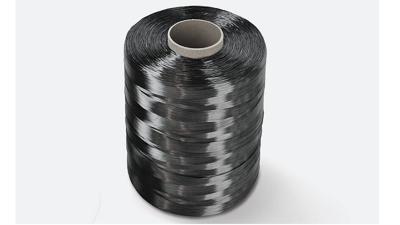Technical Textiles 2/2023

Hendrik van Delden (Source: Gherzi)
During the month of April, a growing number of company representatives will be traveling to the ‘Parc des Expositions‘ in Villepinte close to Paris/France. This is the date of the leading global fair for the composite industry (the JEC World) – meeting the constantly growing interest of textile producers.
Composites can also be summarized under the generic term FRP (fiber reinforced plastics). This term gives a good description of the 2 main components of composites namely fibers (the reinforcing, load bearing element) and plastic (also called matrix) as the forming (non-load bearing) element in the molded part.
Looking back some decades, the fiber component was in essence based on chopped glass fiber – be it as short fibers (for injection molding) or as fiber mat, e.g. for parts produced in the SMC (sheet molding compound) process.
Therefore, when Renault introduced the first generation of the Espace van (multi-purpose vehicle) in 1984, the car’s body was produced in the SMC process. Significant weight savings versus an equivalent alternative produced in steel could not, however, be realized with the (chopped fiber based) SMC process as exploited in the corresponding Renault factory.
Looking back some decades, the fiber component was in essence based on chopped glass fiber – be it as short fibers (for injection molding) or as fiber mat, e.g. for parts produced in the SMC (sheet molding compound) process.
Therefore, when Renault introduced the first generation of the Espace van (multi-purpose vehicle) in 1984, the car’s body was produced in the SMC process. Significant weight savings versus an equivalent alternative produced in steel could not, however, be realized with the (chopped fiber based) SMC process as exploited in the corresponding Renault factory.
Saving weight in comparison to metal-based alternatives – this understanding was then quickly gaining ground – required a number of conceptual changes:
• Use of continuous fibers (so-called rovings) instead of chopped fibers
• Use of reinforcements produced using textile manufacturing technologies (such as wovens, multiaxial NCF fabrics or braids)
• Eventually – dependent on the part and application – replacement of glass fibers by para-aramid or carbon fiber-based reinforcements.
Initially high-performance composites based on these new concepts were restricted to the aeronautic industry and some niche-applications like in racing cars. Today high-performance composites occupy a large share of the market including volume applications like mobility, infrastructure or wind-energy.
Market developments over the last decade have been marked by certain trends, which also are of importance for textile companies intending to grow in the composite domain.
According to the AVK (Federation of Reinforced Plastics) – and assumptions by the author (concerning year 2022 market data) – the European Composite market has, with about 3,065 kt in 2022, already exceeded the pre-Covid volume. In comparison to 2011, the overall market has grown by 28% in 2022.
Within this overall market scenario, however, very different growth trends can be observed when analyzing the time span 2011-2022:
• Thermoplastic compostites have grown by 45% (to about 1,735 kt in 2022) in comparison to thermoset composites, where the volume in the afore-mentioned time span (2011-2022) has only grown by 13%
• The volume of carbon fiber reinforced composites has tripled (to about 58 kt in 2022) in the same period
• NCF (non-crimp fabric) reinforced composites have been able to grow their volume – partially at the expense of wovens – by 45% to about 320 kt in 2022.
What are now the key issues for textile companies upon their entry into the composite domain?
One of the first volume markets for composite reinforcements were glass fiber wovens for PCB’s (printed circuit boards). The delocalization of these markets to Asia and the backward integration of Asian PCB producers into glass fiber wovens some decades ago came as a – in parts survival threatening – shock to European weavers in the composite reinforcement field.
Even today it is not easy to operate profitably as a pure weaver of glass fiber (GF) or carbon fiber (CF) reinforcement fabrics. This is also due to the fact that large multinational GF or CF producers today also supply dry (non-impregnated) wovens. Only the establishment of an impregnation unit (for fabrics impregnated with plastic resin – so-called prepregs) – including the required plastic resin know-how – creates possibilities for differentiation by offering customer specific solutions with higher margins.
Multiaxial NCF fabrics, on the other hand, and - due to their high growth rates – still attractive even as dry (non-impregnated) textile substrates. Here one can still observe technological leaps (e.g. the processing of spread rovings – so-called tapes) having the aim to achieve a higher fiber content in the molded part.
Furthermore, molded parts based on natural fiber reinforcements (flax) enjoy a strong growth in demand. Also resin impregnated prepreg-tapes or prepreg-rovings show an enormous future potential, e.g. for continuous fiber reinforced injection molded parts or in the domain of (winding technology based) pressure vessels.
Important for the entry of textile enterprises into composite markets is the establishment of in-house plastic resin knowhow. Only in this way can textile companies successfully conceive and implement a strategy of differentiation against the big producers of the composite industry.
Hendrik van Delden
Senior Partner
Gherzi Textil Organisation AG,
Zurich / Switzerland
Senior Partner
Gherzi Textil Organisation AG,
Zurich / Switzerland



